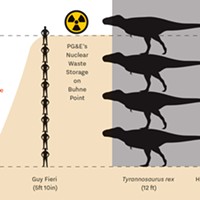Re: '44 Feet' Editor:
[
{
"name": "Top Stories Video Pair",
"insertPoint": "7",
"component": "17087298",
"parentWrapperClass": "fdn-ads-inline-content-block",
"requiredCountToDisplay": "1"
}
]
Re: "44 Feet" by J.A. Savage (Sept. 15): I wish your writer had actually quantified the risks posed by the five dry casks holding spent fuel rods at PG&E's Buhne Point station. What was PG&E's response to the concerns raised here? They were asked, right?
And, for such an important topic, I could do without references to a celebrity cook's hair, beer-drinking and the insomnia suffered by "a former utility employee in the nuclear power industry." (Was he a materials engineer/geologist/safety officer?)
According to your article, the bluff where the casks are now stored has fallen in height by 52 feet since the 1800s. Will it be underwater in 200 years, making "44 Feet" irrelevant?
That "20 inches of sea level rise since 1970" — it's actually about 7 inches. Not insignificant, but also irrelevant, given that 46 feet of water swept over the Fukushima sea wall.
"The safety of the radioactive waste depends on past assumptions and scientific data that no longer apply." I looked in vain for exactly which assumptions and data have been superseded, and how they affect the safety of the casks.
The accidents at working nuclear plants (Fukushima and Chernobyl) seem out of place in a discussion on fuel rod storage.
The article questions the integrity of the million-dollar Hi-Star dry casks which house spent fuel rods at the site, but I've yet to see any reports of a failure of any of the 2,000-plus casks now stored in the U.S. (plus thousands more in 20 other countries). Not incidentally, Fukushima's dry casks were undamaged by the tsunami.
Your writer doesn't mention it, but personally I'd feel better knowing that the air circulation vents (which prevent the casks overheating) are checked for blockages daily at Buhne Point.
Barry Evans, Eureka
Latest in Mailbox
Readers also liked…
-
The Elf on the Shelf is Begging You Not to Put Him Out This Year
- Dec 8, 2022
-
A PG&E Plea
- Feb 23, 2023
































